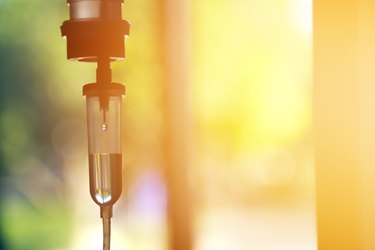
Breast cancer is still the second most common cancer in women (after skin cancer), according to the American Cancer Society (ACS). But continuing advances in research mean that today it is more treatable than ever.
"The field is hopeful," says Stephanie Downs-Canner, MD, assistant professor of surgery at the University of North Carolina in Chapel Hill. "We are continuing to develop new treatments, and researchers and clinicians are doing a much better job paying attention to how the treatments make patients feel so they can have as good a quality of life as possible."
In fact, Bora Lim, MD, assistant professor at the University of Texas MD Anderson Cancer Center in Houston, tells LIVESTRONG.com she has patients who have been living with metastatic breast cancer — cancer that has spread beyond the breast — for more than 20 years.
Here's what you need to know about breast cancer, from screening and diagnosis to symptoms and treatment.
What Exactly Is Breast Cancer?
Simply put, breast cancer is a disease that occurs when cells begin to grow out of control in the breast, per the Centers for Disease Control and Prevention (CDC). Scientists now understand that breast cancer is not just one disease, but several. And, although they all start in the breast, there are multiple ways to classify them, Dr. Lim says.
Usually that's done by identifying where in the breast the cancer started, whether or not it has spread and how far. Most cancers start in the milk-producing glands called the lobules or the ducts that take milk to the nipples, according to the CDC.
Types of Breast Cancer
Non-Invasive
Cancers that are "in situ" or "non-invasive" are those that haven't spread beyond the specific point they originated.
- Ductal carcinoma in situ (DCIS) is a tumor that starts in the milk ducts but has not moved any farther. DCIS accounts for about 20 percent of all breast cancers and is considered curable, according to the ACS. Overall, about 80 percent of breast cancers start in the ducts, says Dr. Lim.
- Lobular carcinoma in situ is another non-invasive tumor caught so early it's not even considered cancer, although it may lead to cancer later on, according to MD Anderson Cancer Center.
Invasive
Invasive cancers are ones that have spread beyond the initial site, either into surrounding breast tissue or even beyond that, per the ACS.
- Invasive ductal carcinoma (IDC), which represents about 70 to 80 percent of invasive breast cancers, starts in the milk ducts but has spread elsewhere, per the ACS.
- Invasive lobular carcinoma (ILC) spreads from the lobules. This type of cancer accounts for about 10 percent of invasive breast malignancies.
Invasive cancers are further divided by what molecular receptors they have. Molecular receptors are binding sites on the cancer cells that "are the major ways they can survive and get nutrition," Dr. Lim says.
For breast cancer cells, receptors can attach to the hormones estrogen or progesterone, or both, per the ACS. There are tests for all of these characteristics that help doctors guide patients to the right treatment, according to the National Cancer Institute (NCI).
- Hormone receptor-positive breast cancer. This includes receptors that bind with estrogen and progesterone, hormones that provide fuel to the malignant cells. This is the most common type of breast cancer, Dr. Downs-Canner says. These tumors usually grow more slowly and are responsive to many different treatments, according to MD Anderson.
- HER2-positive breast cancer. Cancerous cells have higher levels of a protein called HER2 than non-cancerous cells. "It used to be considered the type of breast cancer with the worst prognosis, but now they have really good medication that targets the specific protein," Dr. Downs-Canner says. About half of these cancers are also hormone receptor-positive, per MD Anderson.
- Triple-negative breast cancer. These are cancers that don't have estrogen or progesterone receptors and also do not make high levels of HER2. They're also aggressive and hard to treat. They represent about 10 to 15 percent of all breast cancers, according to the ACS. Triple-negative breast cancer is more common in young women, African American women and women who have the BRCA1 mutation, which increases breast cancer risk, per the ACS.
Inflammatory breast cancer (IBC) is an unusual and aggressive type of cancer, which also tends to target younger women and African American women, as well as those who are overweight or obese, per the ACS. The inflammatory symptoms (like redness and swelling) are caused by cancer cells blocking lymph vessels. IBC is also sub-divided based on what kinds of receptors it has.
"The one thing women can do to prevent breast cancer, the only thing really proven to be beneficial is exercise. Exercise, exercise, exercise."
Less common forms of breast cancer include:
- Paget disease of the breast, which affects the nipple and the surrounding areola, according to the ACS.
- Phyllodes tumor, which grows in the breast's connective tissue rather than the ducts or lobules. Most of these are noncancerous, but they are fast growing, according to Johns Hopkins Medicine.
- Angiosarcoma, which begins in the blood or lymph vessels and often occurs in women who have had radiation treatment to the breast, per the ACS. It can also affect the arms.
- Male breast cancer, which affects about 2,500 men every year in the U.S., according to MD Anderson.
Breast Cancer Symptoms
Breast cancer statistics show most people have no symptoms at all. "That's because we're so good at screening in this country," Dr. Downs-Canner says. Ideally, mammograms and other forms of screening will catch tumors before they actually cause symptoms.
When symptoms do appear, a lump is the most common. Lumps that don't hurt, are hard and have irregular edges are more likely to be cancer, but masses that do have these qualities can also be cancerous, according to the ACS.
"Any lump that's new should be brought to a doctor's attention," Dr. Downs-Canner says.
More subtle skin changes can also be signs of breast cancer, she adds. This includes skin that is retracted or pulled in, nipples that turn inward or a bloody or clear nipple discharge.
Other skin changes might include dimpling, swelling (even with no lump), swollen lymph nodes or skin that starts flaking or is red and dry, according to the ACS.
Symptoms of inflammatory breast cancer can look like an infection, Dr. Downs-Canner says. "The breast generally is red, hot, sometimes heavy and swollen. There may not be a discrete mass."
The ACS recommends being familiar with how your breasts normally look so you'll notice if any changes do occur.
Breast Cancer Causes and Risk Factors

Both genetics and environmental factors can play a role in raising or lowering your risk for breast cancer.
Five to 10 percent of all breast cancers are hereditary, according to the ACS. That means they're caused by a gene mutation or mutations that you got from your parents. Women with a mother, sister or daughter with breast cancer have double the risk of developing the disease, per the ACS.
The best-known of these mutations are BRCA1 and BRCA2. "If you're born with these, you have an 80 percent lifetime risk of developing breast cancer," Dr. Lim says. BRCA1 and 2 can also cause ovarian cancer, per Memorial Sloan-Kettering Cancer Center in New York City.
There are several other gene mutations implicated in breast cancer, including the ATM, TP53, CHEK2 and PTEN genes. (There are genetic tests for many of these mutations.) And there are many others we don't know about yet, Dr. Lim adds.
There are also a number of other factors that can affect your risk for breast cancer:
- Age. Your risk of getting breast cancer increases as you get older, with most cases diagnosed after the age of 50, per MD Anderson.
- Starting your period early. Women who started menstruating before the age of 12 are more likely to get breast caner.
- Going through menopause late. The longer a woman menstruates in her lifetime, the more estrogen she is exposed to. Estrogen exposure raises the risk of breast cancer.
- Not having children or having children later in life. Again, this increases your exposure to estrogen over a lifetime, per the NCI.
- Having dense breasts. Dense breasts are characterized as having a lot of fibrous connective tissue or lobules, without a lot of fat, according to the ACS. Density can be hereditary, but it may also have to do with not getting pregnant until later in life, taking hormone replacement therapy after menopause or drinking alcohol, per the NCI.
- A previous history of breast cancer or benign breast disease.
- Previous radiation therapy to the breast. Prior treatment can increase the risk of cancer in the same breast, but not the other, according to the NCI.
- Hormone replacement therapy, sometimes taken to relieve hot flashes and other symptoms of menopause.
- Drinking alcohol.
- Obesity, especially among older women. That's because fatty tissue produces more estrogen.
There are also a number of things that can lower your odds of developing breast cancer, including:
- Having a preventive mastectomy, usually done if you have a high-risk gene mutation like BRCA1 or BRCA2. There are genetic tests for both of these genes, as well as others.
- Starting your period later and/or going through menopause earlier.
- Getting pregnant early and breastfeeding also lower your overall exposure to estrogen.
- Taking certain medications including estrogen-only hormone therapy after a hysterectomy, tamoxifen and other selective estrogen receptor modulators (SERMs), aromatase inhibitors like anastrozole and aromatase inactivators like exemestane. Bear in mind, these drugs can raise the risk of other health problems.
- Oophorectomy. Removing both ovaries, which produce estrogen, lowers the risk of breast cancer, per the NCI.
- Exercising at least four times a week is associated with a lower risk of breast cancer, and of breast cancer returning. "The one thing women can do to prevent [breast cancer], the only thing really proven to be beneficial is exercise," Dr. Lim says. "Exercise, exercise, exercise." Even reducing dietary fat and adding more fruits and vegetables have not been found to reduce the risk for breast cancer, per the NCI.
The jury is still out on whether hormonal contraceptives like the pill or environmental factors like chemicals have any effect on breast cancer risk.
Breast Cancer Screening and Diagnosis

"Screening tests for breast cancer don't prevent cancer, but they can catch tumors in earlier stages when they're more easily treated," Dr. Downs-Canner says.
All breast cancer screening techniques have pluses and minuses. Minuses can include false positives and false negatives (when actual cancers are missed).
Mammograms are the most common form of screening, per the NCI. These are basically low-dose X-rays of your breasts.
Different organizations have different recommendations for how often you should get mammograms and when you should start. For instance, the U.S. Preventive Services Task Force (USPSTF) recommends that women ages 50 to 74 get a mammogram every other year, while the ACS recommends annual mammograms between the ages of 45 to 54, with mammograms every other year for women over age 55.
Those guidelines are for people with an average risk of breast cancer, Dr. Downs-Canner says. If you're high risk, you'll need to be screened more frequently.
"If your mom or another first-degree relative had a diagnosis of breast cancer, we recommend that you start mammograms 10 years before the age they were diagnosed," Dr. Lim says.
Other types of imaging can also be used to check for breast cancer, such as:
- Ultrasound. This uses sound waves to create a picture of your breasts. It's similar to what's used during pregnancy.
- Magnetic resonance imaging (MRI). This creates a more detailed picture of the breast but it can also turn up a lot of false positives, Dr. Downs-Canner says. These are recommended for people at higher risk for breast cancer, she adds. That includes people with one of the BRCA gene mutations, according to the NCI.
- 3-D mammograms. These use moving X-rays to create a more three-dimensional picture of the breast, according to Cedars-Sinai Hospital in Los Angeles. This type of imaging may help detect cancer in women with dense breasts, Dr. Lim says.
At regular doctor's visits, your health care providers should also do a clinical breast exam, which involves manually feeling the breasts for lumps or other potential problems.
If any of these tests do show something unusual, doctors will usually order additional imaging tests and, if those look suspicious, perform a biopsy, according to the ACS. That's when cells are taken out of the breast and scrutinized under a microscope, the NCI explains.
If your doctor suspects your cancer may have spread, he or she may order other tests such as chest X-rays, CT scans, bone scans, PET scans or MRI scans, according to the ACS.
Breast Cancer Stages
If different tests determine that you do have breast cancer, doctors will do additional tests to see if the cancer has spread and, if so, where. They'll use this to divide the tumor into stages and that will inform you and your doctor's decisions on treatment.
The most common staging system is the TNM system, according to the American Society for Clinical Oncology (ASCO). This stands for Tumor Nodes Metastasis and looks at three factors:
- The size and location of the main tumor.
- Whether or not the tumor has spread to the lymph nodes and, if so, which lymph nodes and how many.
- Whether or not the cancer has metastasized or spread to other parts of the body, and, if so, where.
This information is combined with information on receptor status to help determine which stage the cancer is in. Stage 0 means it hasn't spread at all (for instance, DCIS), while 4 means the cancer has metastasized to other areas, such as distant lymph nodes, the brain, bones or liver. Each stage also has substages.
Breast Cancer Treatment

Just as there are many types of breast cancer, there are also today many, many different types of treatments. "I tell my patients that just because your neighbor had breast cancer and this is the treatment they got, it may have nothing to do with the treatment you need," Dr. Downs-Canner says.
The NCI identifies six different types of standard treatment for breast cancer.
1. Surgery
If doctors are treating patients in the hopes of bringing about a cure, surgery is always involved, Dr. Downs-Canner says. In times past, a radical mastectomy (removing the breast, under-the-arm lymph nodes and chest muscles) was pretty much the only option, per the NCI.
Today, Dr. Downs-Canner says, "the amount of surgery is much less." Radical mastectomies are still performed but there are many other types of surgery as well.
- Simple mastectomy takes out the whole breast and, sometimes, nearby lymph nodes. The lymph node surgery may or not be done at the same time as the mastectomy.
- Modified radical mastectomy removes the breast, many of the lymph nodes under the arm and sometimes part of the muscles in the chest wall.
- Breast-conserving surgery or lumpectomy removes only the cancer and some tissue around it and sometimes part of the chest wall lining. This is also called a partial mastectomy.
2. Chemotherapy
These are drugs used to find and kill cancer cells or to stop them from multiplying, per the NCI. There are many different types of chemotherapy and they can be given before surgery to shrink a large tumor (neoadjuvant or preoperative chemo), or after surgery to eradicate any remaining cancer cells not found by the surgeon's scalpel, according to the NCI.
"Patients with locally advanced or big cancers most of the time need chemotherapy," Dr. Downs-Canner says. This also includes inflammatory breast cancer.
3. Radiation Therapy
This uses high-energy X-rays or radiation pointed right at the cancer to eradicate it and lower the chances of a recurrence. "Generally, most women who are getting a lumpectomy require radiation except in special circumstances like older women with slow-growing tumors," Dr. Downs-Canner says.
4. Hormone Therapy
Hormone therapy treats hormone-receptor-positive tumors by removing or blocking the hormones that help the cancer grow. The number of medications in this class has exploded over the past few years. The main ones are:
- Tamoxifen, often used in conjunction with other therapies for early cancers that haven't spread, as well as for metastatic breast cancer, according to the NCI.
- Luteinizing hormone-releasing hormone agonists, which turn off the ovaries, per the ACS.
- Aromatase inhibitors, which block an enzyme that converts androgen into estrogen.
5. Targeted Therapy
Most of these drugs target the HER2 receptor. The best known is Herceptin. Some others are:
- Monoclonal antibodies, which neutralize HER2. One of these drugs (called sacituzumab govitecan) is in trials to see if it works against triple-negative breast cancer.
- Tyrosine kinase inhibitors, which also block HER2.
- Cyclin-dependent kinase inhibitors, which are for HER2-negative and ER-positive cancers that have spread.
6. Immunotherapy
These are drugs which harness the body's own immune system to fight the cancer. They're also known as biologic therapy.
Is this an emergency? If you are experiencing serious medical symptoms, please see the National Library of Medicine’s list of signs you need emergency medical attention or call 911.